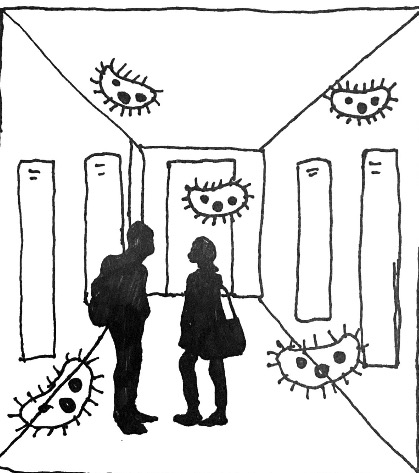On March 23, 2021, the Redwood community was emailed big news: all schools in the Tamalpais Union High School District (TUHSD) would be returning to 100 percent in-person learning beginning April 13. Students now have the opportunity to either be fully in-person or remain completely remote, however, there is an opportunity to switch to in-person later in the year. The district made the decision because of the recent updates to the COVID-19 guidelines that allow for a smaller social distance standard of three feet. Additionally, all district staff members have had the opportunity to be vaccinated. Nonetheless, the majority of the student body feels unprotected as well as stressed by the quick transition into 100 percent in-person learning.
According to a Cub-Bark survey in April, only 27 percent of the Redwood student population feels protected from COVID-19 when on campus. Students are concerned about the ability to social distance in hallways as well as the lack of vaccination among the younger student body. Over 77 percent of Marin residents over the age of sixteen have been vaccinated, including the majority of teachers, but the remaining underclassmen population is not vaccinated, meaning that a potential COVID-19 outbreak is possible.
Even though the TUHSD administration went through a diligent process to ensure student and staff safety, students are still concerned about returning to campus full time. The Cub-Bark survey highlighted aspects that concerned students the most, which included crowded hallways, student exposure after spring break, partying on weekends, travel and many questions regarding lunch periods.
Principal David Sondheim addressed some of these concerns.
“Significant contact is considered fifteen minutes or more within three feet with masks on and so while the hallways in between periods will be crowded [with] people closer than three feet, it will be for a limited amount of time,” Sondheim said. “It will be short enough that it will be OK.”

Sondheim also explained that there is not an easy solution to this problem, but, on the brighter side, students are following the current guidelines the school has put in place. Although while walking in the hallways and sitting in class it is noticeable that some students wear their masks incorrectly or forget to put them back on after drinking a beverage. Both of these disregard the safety measures put in place to protect Redwood Giants. Sondheim and the administration continue to clarify the lunchtime regulations.
“The lunch periods will look the same, but with more people. We are hoping people will use the south lawn; more people may use the field behind the amphitheater, and other parts of campus, including the parking lot,” Sondheim said.
To ensure students are being safe, it is suggested that they spread out all around campus and that students stay six feet apart when masks are off to eat. Unfortunately, in the past two weeks, it has been seemingly obvious that students aren’t keeping a safe distance at lunch; the back lacrosse fields have a large number of students, students can also be found eating in close proximity to each other in their car trunks and staff has to repeatedly ask students to separate.
It’s important to understand that the administration and staff are trying their best to ensure safety, but despite these guidelines, many students’ concerns are not eased. The solution that Redwood has provided for this general feeling of discomfort is minimum; students who feel unsafe can remain online troubleshooting zoom, but their teacher’s main priority is always on students in person. This being the only option is unfair to students who feel unsafe being on campus. Better solutions could have been keeping Mondays virtual or slowing the transition by having two cohorts, both of which allow for easier adjustments into this big change.
It was a quick transition that was thrown at students and teachers, who are frustrated, worried and concerned to be at 100 percent capacity. There are other measures that need to be taken for students to feel safer, and they only work if students and staff are consistently following them.





